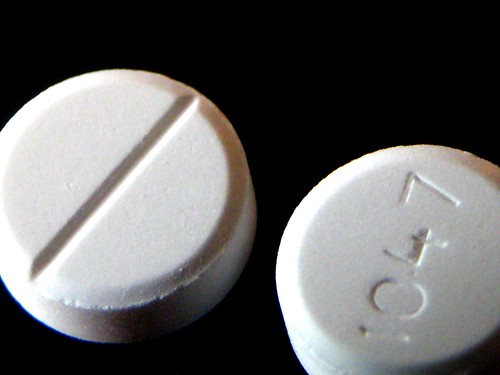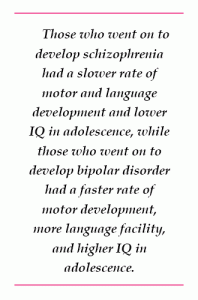Lamotrigine for BP II depression: Not FDA-Approved, but Likely Effective
At the 4th Biennial Conference of the International Society for Bipolar Disorders in Sao Paulo, Brazil in March, Jae Seung Chang of South Korea reported that in a year-long naturalistic, open label study of long-term adjunctive lamotrigine therapy in 109 patients with bipolar II depression, depression severity decreased when lamotrigine was added to patients’ regular treatment with mood stabilizers.

Interestingly, in addition to the data on lamotrigine, these investigators also found that having had a higher number of prior episodes was associated with a decreased response to lithium, a finding that has often been reported in the literature. Another finding was that a history that included a serious suicide attempt was associated with a decreased lamotrigine response. Read more
Schizophrenia v. Bipolar Disorder: Different Risk Factors
 Robin Murray gave a plenary presentation at the 65th Annual Scientific Convention of the Society of Biological Psychiatry this year, in which he indicated that the genetic risk for schizophrenia and other major mental disorders may be overestimated. He suggested that even in identical twins there are considerable differences in incidence of major psychiatric illnesses, and sharing an environment could further inflate the appearance of genetic risk.
Robin Murray gave a plenary presentation at the 65th Annual Scientific Convention of the Society of Biological Psychiatry this year, in which he indicated that the genetic risk for schizophrenia and other major mental disorders may be overestimated. He suggested that even in identical twins there are considerable differences in incidence of major psychiatric illnesses, and sharing an environment could further inflate the appearance of genetic risk.
Evidence of some genetic vulnerability factors, such as neuregulin, disbindin, DISC-1, zinc finger transcription factors, and neurexin, has been replicated. However, these genes appear to contribute only about 1% of the vulnerability to schizophrenia or bipolar illness. Copy number variations (CNVs, extra or missing copies of a gene, which may alter its activity) and gene micro-deletions (in which small bits of DNA are missing) have been found in about 5% of patients with schizophrenia, in some patients with autism and mental disabilities, but not in those with bipolar illness.
Murray emphasized the importance of psychosocial and neuromotor markers of neural development in determining risk of subsequent major psychiatric illness, rather than the relatively weak genetic effects. He cited the work of MacCabe (2009), who collected information from 907,000 individuals in Sweden. Their scholastic achievement at age 15?16 was rated, and hospitalizations for psychosis were recorded from age 17?31. Of the 315,000 followed for the long term, 493 developed schizophrenia and 208 developed bipolar disorder.
Predictors of cognitive and motor development in these two major psychiatric illnesses appeared to differ. In those who went on to develop schizophrenia, there was a slower rate of motor development, receptive language, and overall IQ in adolescence, while in those who went on to develop bipolar disorder, there was a faster rate of motor development, more language facility, and higher IQ in adolescence.
Early Life Stressors Linked to Persistent Inflammation and Endocrine Abnormalities
Epigenetics is a relatively new area of study that examines changes in DNA regulation and structure that can come about as a result of environmental events, as opposed to the genetic inheritance (DNA sequence) people receive through their parents’ genes. Epigenetic effects occur when an environmental stressor or chemical causes methyl or acetyl groups to attach to DNA or to histones (around which DNA are wound). These epigenetic changes determine how difficult it is to turn on genes coded in the DNA (see here for more information about the way the environment produces these epigenetic effects).
After the jump: Several studies presented at the 65th Annual Scientific Convention of the Society of Biological Psychiatry earlier this year suggested a link between environmental stress and both inflammation and abnormalities in DNA.
 Read more
Read more
rTMS for Adolescent Depression
In an abstract presented at the 65th Annual Scientific Convention of the Society of Biological Psychiatry, Christopher Wall reported that treatment with rTMS (10 Hz at 120% of motor threshold) was successful in the treatment of adolescent depression.
These data from an open (as opposed to blind) study deserve further and more systematic investigation. Alternatives to antidepressant drug treatment are desirable for adolescents with depression since increases in suicidal ideation are a potential side effect during the first two months after initiation of pharmacological antidepressant treatment in teens. (Suicidal ideation and actions among adolescents decrease with longer-term antidepressant treatment, especially when it is used in conjunction with cognitive/behavioral psychotherapy.) Children and adolescents treated with antidepressants may also be at higher risk for switching into mania than adults treated with antidepressants.
Editor’s Note: The rTMS parameters used in this study are the same as those used successfully in adults with depression in the two large positive multi-center sham-controlled studies (one by industry and one by the National Institute of Mental Health) mentioned in yesterday’s article.
New Developments in Repeated Transcranial Magnetic Stimulation (rTMS)
 At the 65th Annual Scientific Convention of the Society of Biological Psychiatry, several findings related to repeated transcranial magnetic stimulation (rTMS) were reported.
At the 65th Annual Scientific Convention of the Society of Biological Psychiatry, several findings related to repeated transcranial magnetic stimulation (rTMS) were reported.
E. Baron Short reported that two weeks of 10 Hz rTMS at 120% of motor threshold (MT) was highly effective in the treatment of fibromyalgia. Pain ratings decreased 45% by day six and 80% by day 10 in this randomized sham-controlled double-blind study.
Also at the convention, Motoaki Nakamura reported that either 1 Hz or 20 Hz rTMS at 90-100% of motor threshold over left prefrontal cortex in depressed patients increased gray matter in left dorsolateral prefrontal cortex and left hippocampus in association with almost 50% reductions in Hamilton depression rating scale scores and associated increases in performance on the Wisconsin card sort test. Read more
Brain Volume Reduced As Early As First Episode Of Mania
 Researchers Manpreet K. Singh and Kiki D. Chang et al. from Stanford reported at the 65th Annual Scientific Convention of the Society of Biological Psychiatry that adolescents experiencing a first episode of mania show reduced volume in the subgenual anterior cingulate cortex (Brodmann area 25). Previous studies have indicated that teens and adults with bipolar disorder exhibit decreased volume in prefrontal gray matter. Read more
Researchers Manpreet K. Singh and Kiki D. Chang et al. from Stanford reported at the 65th Annual Scientific Convention of the Society of Biological Psychiatry that adolescents experiencing a first episode of mania show reduced volume in the subgenual anterior cingulate cortex (Brodmann area 25). Previous studies have indicated that teens and adults with bipolar disorder exhibit decreased volume in prefrontal gray matter. Read more
Uric Acid Increases During Mania
At the 65th Annual Scientific Convention of the Society of Biological Psychiatry this year, Giacomo Salvadore reported that significantly higher levels of uric acid are found in patients with mania compared with normal controls.
Editor’s note: This study was particularly interesting because there was a highly significant difference between patients and controls, with very few values overlapping. The data suggest the possibility that uric acid may be a useful biological marker for mania, and is one that should be studied in childhood-onset bipolar illness to determine whether uric acid is a marker for mania in children as well.
Allopurinol, a widely used treatment for gout that reduces levels of uric acid in the blood, is an effective antimanic agent (based on data from two placebo-controlled studies, one by Machado-Vieira et al. and one by Akhondzadeh et al.). The new data on uric acid raise the possibility that high levels of uric acid may be a specific predictor of responsiveness to Allopurinol, although this hypothesis has not yet been explored.
In an article by Chung et al. just published in Psychiatry Research, it was reported that in a very large epidemiological study in Taiwan, patients with bipolar disorder have increased risk of gout.
Oxytocin, the Social Affiliation Drug, Has Interesting Effects in Autism and Now Schizophrenia
 In 2007, investigator E. Hollander from Mt. Sinai published data indicating that intranasal oxytocin was associated with increases in target behaviors in patients with autism.
In 2007, investigator E. Hollander from Mt. Sinai published data indicating that intranasal oxytocin was associated with increases in target behaviors in patients with autism.
Now a study by David Feifel of the University of California, San Diego presented at the 65th Annual Scientific Convention of the Society of Biological Psychiatry showed that patients with schizophrenia showed improvement in symptomatology and increases in the recognition of positive facial affect after oxytocin was added to their antipsychotics regimen. Morris Goldman of Northwestern University reported that patients with schizophrenia, who often make mistakes assessing fear on facial emotion recognition tests, described fewer faces as fearful after receiving intranasal oxytocin.
Editors note: These new findings are built on the pioneering preclinical work of Tom Insel. He found marked differences in oxytocin and its receptors in the brains of mountain voles (who are largely asocial) compared to prairie voles (who are highly social and form lifelong bonds with their mates). Although these oxytocin findings have not yet produced a treatment for any psychiatric syndrome, they illustrate the potential of general scientific findings to inform new approaches to human illnesses.
Children with ADHD and Oppositional Symptoms Respond to Guanfacine
Researcher Daniel Connor reported at the 65th Annual Scientific Convention of the Society of Biological Psychiatry that children aged 6-12 with oppositional symptomatology and attention-deficit/hyperactivity disorder (ADHD) improved on guanfacine XR.
Doses ranged from 1 to 4 mg/day, with a mean dose of 2.9 mg/day. There was a substantial decrease in oppositionality (a finding with a moderate effect size of 0.59) and a marked decrease in ADHD symptomatology (a finding with a large effect size of 0.92). Side effects included drowsiness (in 51% of subjects), headache (22%), sedation (13%), abdominal pain (12%) and fatigue (11%). Guanfacine is not a psychomotor stimulant, like most of the treatments for ADHD are, but an agonist (activator) of noradrenergic ?2 receptors in the brain.
Deep Brain Stimulation
 In the 1990s, the pioneering studies of Helen Mayberg and colleagues showed that stimulation of an area in the ventral part of the prefrontal cortex called the subgenual anterior cingulate gyrus (or Brodmann area 25, the part of the brain under the anterior corpus collosum) is associated with improvement in depression that resisted almost all other treatments. At the 65th Annual Scientific Convention of the Society of Biological Psychiatry this year, a number of research groups reported following up on Mayberg’s studies. The latest positive data on stimulation of Brodmann area 25 for treatment-resistant depression mirror new findings from other research groups who have stimulated the dopaminergic reward area of brain called the nucleus accumbens or ventral striatum with successful results.
In the 1990s, the pioneering studies of Helen Mayberg and colleagues showed that stimulation of an area in the ventral part of the prefrontal cortex called the subgenual anterior cingulate gyrus (or Brodmann area 25, the part of the brain under the anterior corpus collosum) is associated with improvement in depression that resisted almost all other treatments. At the 65th Annual Scientific Convention of the Society of Biological Psychiatry this year, a number of research groups reported following up on Mayberg’s studies. The latest positive data on stimulation of Brodmann area 25 for treatment-resistant depression mirror new findings from other research groups who have stimulated the dopaminergic reward area of brain called the nucleus accumbens or ventral striatum with successful results.
In one of the first systematic studies intended to identify the best frequency and pulse width duration parameters for this type of intracranial stimulation in patients with treatment-resistant depression, researcher Swati Chavda of the University of Calgary reported that patients with depression improved when they were stimulated at 130 Hz (cycles/sec.) with a pulse width of 90 micro-seconds. In this double-blind study, depression neither improved nor worsened under other conditions, such as when the stimulation was turned off, when a low frequency (20 Hz) was used, or when much higher frequencies (185 Hz) with a pulse width of 420 micro-seconds were used.
Editor’s note: These data indicate that the positive effects of deep brain stimulation on clinical depression may depend on the frequencies used, with more intermediate stimulation parameters better than very high or very low ones. More clinical exploration is required in order to define optimal stimulation parameters for different brain regions. For the moment, this type of deep brain stimulation remains highly experimental, but is being pursued by a number of investigative groups in the US and Europe.

